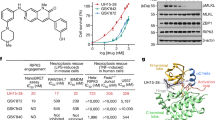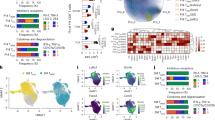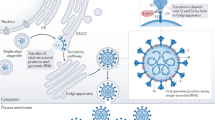Abstract
At present, little is known about the pathogenesis of acute virus-induced shock and pulmonary failure. A chief impediment in understanding the underlying disease mechanisms and developing treatment strategies has been the lack of a suitable animal model. This study describes a mouse model of virus-induced systemic shock and respiratory distress, and shows that blockade of the lymphotoxin beta receptor pathway reverses the disease.
This is a preview of subscription content, access via your institution
Access options
Subscribe to this journal
Receive 12 print issues and online access
$209.00 per year
only $17.42 per issue
Buy this article
- Purchase on Springer Link
- Instant access to full article PDF
Prices may be subject to local taxes which are calculated during checkout







Similar content being viewed by others
References
Lacy, M.D. & Smego, R.A. Viral hemorrhagic fevers. Adv. Pediatr. Infect. Dis. 12, 21–53 (1996).
Peters, C.J. in Viral Pathogenesis (ed. Nathanson, N.) 779–799 (Lippincott-Raven, Philiadelphia, 1997).
No author given. Hantavirus pulmonary syndrome—Colorado and New Mexico, 1998. Morbid. Mortal. Weekly Report 47, 449–452 (1998).
Toro, J. et al. An outbreak of hantavirus pulmonary syndrome, Chile, 1997. Emerg. Infect. Dis. 4, 687–694 (1998).
Zaki, S.R. et al. Hantavirus pulmonary syndrome. Pathogenesis of an emerging infectious disease. Am. J. Pathol. 146, 552–579 (1995).
Zaki, S.R. et al. Retrospective diagnosis of hantavirus pulmonary syndrome, 1978-1993: implications for emerging infectious diseases. Arch. Pathol. Lab. Med. 120, 134–139 (1996).
Nolte, K.B. et al. Hantavirus pulmonary syndrome in the United States: a pathological description of a disease caused by a new agent. Hum. Pathol. 26, 110–120 (1995).
Hallin, G.W. et al. Cardiopulmonary manifestations of hantavirus pulmonary syndrome. Crit. Care Med. 24, 252–258 (1996).
Talal, N. & Steinberg, A.D. The pathogenesis of autoimmunity in New Zealand black mice. Curr. Top. Microbiol. Immunol. 64, 79–103 (1974).
Ahmed, R. & Oldstone, M.B. Organ-specific selection of viral variants during chronic infection. J. Exp. Med. 167, 1719–1724 (1988).
Matloubian, M., Kolhekar, S.R., Somasundaram, T. & Ahmed, R. Molecular determinants of macrophage tropism and viral persistence: importance of single amino acid changes in the polymerase and glycoprotein of lymphocytic choriomeningitis virus. J. Virol. 67, 7340–7349 (1993).
Sheehan, K.C., Ruddle, N.H. & Schreiber, R.D. Generation and characterization of hamster monoclonal antibodies that neutralize murine tumor necrosis factors. J. Immunol. 142, 3884–3893 (1989).
Wong, G.H. & Goeddel, D.V. Tumour necrosis factors alpha and beta inhibit virus replication and synergize with interferons. Nature 323, 819–22 (1986).
Beutler, B., Milsark, I.W. & Cerami, A.C. Passive immunization against cachectin/tumor necrosis factor protects mice from lethal effect of endotoxin. Science 229, 869–871 (1985).
Mackay, F. et al. Cytotoxic activities of recombinant soluble murine lymphotoxin-alpha and lymphotoxin-alpha beta complexes. J. Immunol. 159, 3299–3310 (1997).
Crowe, P.D. et al. A lymphotoxin-beta-specific receptor. Science 264, 707–710 (1994).
Hober, D. et al. Serum levels of tumor necrosis factor-alpha (TNF-alpha), interleukin-6 (IL-6), and interleukin-1 beta (IL-1 beta) in dengue-infected patients. Am. J. Trop. Med. Hyg. 48, 324–231 (1993).
Bethell, D.B. et al. Pathophysiologic and prognostic role of cytokines in dengue hemorrhagic fever. J. Infect. Dis. 177, 778–782 (1998).
Force, W.R. et al. Mouse lymphotoxin-beta receptor. Molecular genetics, ligand binding, and expression. J. Immunol. 155, 5280–5288 (1995).
Miller, G.T. et al. Specific interaction of lymphocyte function-associated antigen 3 with CD2 can inhibit T cell responses. J. Exp. Med. 178, 211–222 (1993).
Browning, J.L. et al. Characterization of surface lymphotoxin forms. Use of specific monoclonal antibodies and soluble receptors. J. Immunol. 154, 33–46 (1995).
Abe, Y. et al. Studies of membrane-associated and soluble (secreted) lymphotoxin in human lymphokine-activated T-killer cells in vitro. Lymphokine Cytokine Res. 11, 115–121 (1992).
Ware, C.F., Crowe, P.D., Grayson, M.H., Androlewicz, M.J. & Browning, J.L. Expression of surface lymphotoxin and tumor necrosis factor on activated T, B, and natural killer cells. J. Immunol. 149, 3881–3888 (1992).
Browning, J.L. et al. Lymphotoxin beta, a novel member of the TNF family that forms a heteromeric complex with lymphotoxin on the cell surface. Cell 72, 847–856 (1993).
Mauri, D.N. et al. LIGHT, a new member of the TNF superfamily, and lymphotoxin alpha are ligands for herpesvirus entry mediator. Immunity 8, 21–30 (1998).
Montgomery, R.I., Warner, M.S., Lum, B.J. & Spear, P.G. Herpes simplex virus-1 entry into cells mediated by a novel member of the TNF/NGF receptor family. Cell 87, 427–436 (1996).
Sayer, W.J., Entwhisle, G., Uyeno, B. & Bignall, R.C. Cortisone therapy of early epidemic hemorrhagic fever: a preliminary report. Ann. Int. Med. 42, 839–851 (1955).
Mertz, G.J., Hjelle, B.L., Williams, T.M. & Koster, F.T. Host responses in the hantavirus cardiopulmonary syndrome. in Emergence and Control of Rodent-Borne Viral Diseases 43, p.43 (Marcel Merieux Foundation, Annecy, France, 1998).
Ahmed, R., Salmi, A., Butler, L.D., Chiller, J.M. & Oldstone, M.B. Selection of genetic variants of lymphocytic choriomeningitis virus in spleens of persistently infected mice. Role in suppression of cytotoxic T lymphocyte response and viral persistence. J. Exp. Med. 160, 521–540 (1984).
Dialynas, D.P. et al. Characterization of the murine T cell surface molecule, designated L3T4, identified by monoclonal antibody GK1.5: similarity of L3T4 to the human Leu-3/T4 molecule. J. Immunol. 131, 2445–2451 (1983).
Sourdive, D.J. et al. Conserved T cell receptor repertoire in primary and memory CD8 T cell responses to an acute viral infection. J. Exp. Med. 188, 71–82 (1998).
Altman, J.D. et al. Phenotypic analysis of antigen-specific T lymphocytes. Science 274, 94–96 (1996).
Zajac, A.J. et al. Viral immune evasion due to persistence of activated T cells without effector function. J. Exp. Med. 188, 2205–2213 (1998).
Murali-Krishna, K. et al. Counting antigen-specific CD8 T cells: a reevaluation of bystander activation during viral infection. Immunity 8, 177–187 (1998).
Acknowledgements
We thank P. Greer and T. Ferebee for their technical assistance in generating and staining tissue sections, and E. Halloran for advice on statistical analysis. This work was funded in part by NIH grants AI09866, AI30048 and NS21496. All animals used in experiments described here were treated in accordance with Emory University's guidelines.
Author information
Authors and Affiliations
Corresponding author
Rights and permissions
About this article
Cite this article
Puglielli, M., Browning, J., Brewer, A. et al. Reversal of virus-induced systemic shock and respiratory failure by blockade of the lymphotoxin pathway. Nat Med 5, 1370–1374 (1999). https://doi.org/10.1038/70938
Received:
Accepted:
Issue Date:
DOI: https://doi.org/10.1038/70938
This article is cited by
-
Fine-tuning of dendritic cell biology by the TNF superfamily
Nature Reviews Immunology (2012)
-
The unexpected role of lymphotoxin β receptor signaling in carcinogenesis: from lymphoid tissue formation to liver and prostate cancer development
Oncogene (2010)
-
Genomic organization and phylogenetic utility of deer mouse (Peromyscus maniculatus) lymphotoxin-alpha and lymphotoxin-beta
BMC Immunology (2008)
-
Personal glimpses of Robert A. Good
Immunologic Research (2007)
-
LIGHT-related molecular network in the regulation of innate and adaptive immunity
Immunologic Research (2007)



